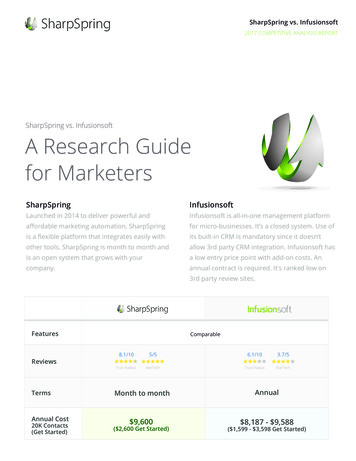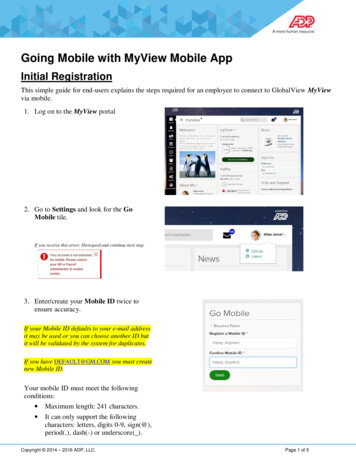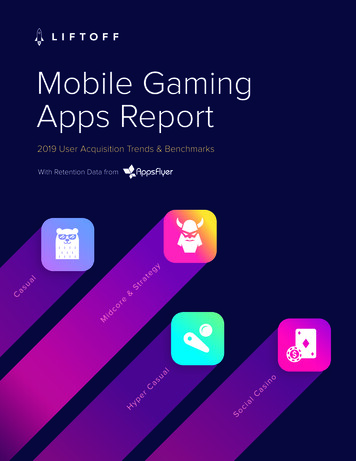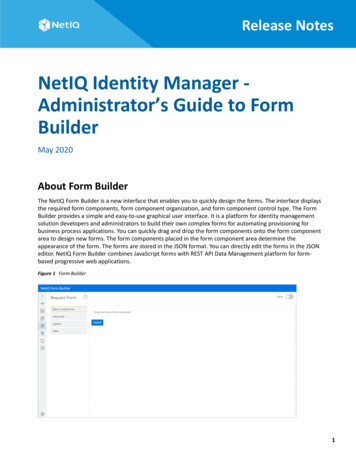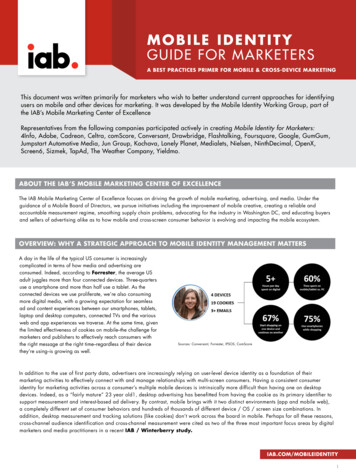
Transcription
Mobile Identityguide for Marketersa best practices primer for mobile & cross-device marketingThis document was written primarily for marketers who wish to better understand current approaches for identifyingusers on mobile and other devices for marketing. It was developed by the Mobile Identity Working Group, part ofthe IAB’s Mobile Marketing Center of ExcellenceRepresentatives from the following companies participated actively in creating Mobile Identity for Marketers:4Info, Adobe, Cadreon, Celtra, comScore, Conversant, Drawbridge, Flashtalking, Foursquare, Google, GumGum,Jumpstart Automotive Media, Jun Group, Kochava, Lonely Planet, Medialets, Nielsen, NinthDecimal, OpenX,Screen6, Sizmek, TapAd, The Weather Company, Yieldmo.About the IAB’s Mobile Marketing Center of ExcellenceThe IAB Mobile Marketing Center of Excellence focuses on driving the growth of mobile marketing, advertising, and media. Under theguidance of a Mobile Board of Directors, we pursue initiatives including the improvement of mobile creative, creating a reliable andaccountable measurement regime, smoothing supply chain problems, advocating for the industry in Washington DC, and educating buyersand sellers of advertising alike as to how mobile and cross-screen consumer behavior is evolving and impacting the mobile ecosystem.OVERVIEW: Why a strategic approach to mobile identity management mattersA day in the life of the typical US consumer is increasinglycomplicated in terms of how media and advertising areconsumed. Indeed, according to Forrester, the average USadult juggles more than four connected devices. Three-quartersuse a smartphone and more than half use a tablet. As theconnected devices we use proliferate, we’re also consumingmore digital media, with a growing expectation for seamlessad and content experiences between our smartphones, tablets,laptop and desktop computers, connected TVs and the variousweb and app experiences we traverse. At the same time, giventhe limited effectiveness of cookies on mobile--the challenge formarketers and publishers to effectively reach consumers withthe right message at the right time--regardless of their devicethey’re using--is growing as well.Sources: Conversant, Forrester, IPSOS, ComScoreIn addition to the use of first party data, advertisers are increasingly relying on user-level device identity as a foundation of theirmarketing activities to effectively connect with and manage relationships with multi-screen consumers. Having a consistent consumeridentity for marketing activities across a consumer’s multiple mobile devices is intrinsically more difficult than having one on desktopdevices. Indeed, as a “fairly mature” 23 year old1, desktop advertising has benefitted from having the cookie as its primary identifier tosupport measurement and interest-based ad delivery. By contrast, mobile brings with it two distinct environments (app and mobile web),a completely different set of consumer behaviors and hundreds of thousands of different device / OS / screen size combinations. Inaddition, desktop measurement and tracking solutions (like cookies) don’t work across the board in mobile. Perhaps for all these reasons,cross-channel audience identification and cross-channel measurement were cited as two of the three most important focus areas by digitalmarketers and media practitioners in a recent IAB / Winterberry study.iab.com/mobileidentity1
Mobile Identity guide for Marketersa best practices primer for mobile & cross-device marketingIn order to capture similar metrics, reporting and ROI that’s available on desktop, advertisers on mobile must leverage a mix of tactics andsolutions. Even though it does take time to understand how to “get it right” on mobile, there is an extraordinary upside for marketers whoput in the effort. As consumer time spent on mobile continues to grow, personalization of advertising and content at scale becomes moretangible, not only in single mobile device settings, but in multiple connected device environments as well. By accurately identifying individualusers and establishing profiles of their behaviors, advertisers can create and manage consistent models of user identity needed to: Track ad exposure (enabling personalized, creative sequential messaging and management of reach and frequency) Attribute online and offline conversions, including store visitations (to impressions served through mobile and cross-device media) Match mobile devices (e.g.; smartphones and tablets) to computers (e.g.: desktops and laptops) enabling targeting and retargeting(especially important in the context of online retailing, where nearly three quarters of shopping carts are abandoned) Link devices to physical locations and offline activity Connect with consumers as they move from in-app to mobile web experiences and to and from various social media platforms Analyze viewability (to understand the amount of time consumers are actually spending with a brand beforeconverting online or in store)HOW IDENTITY IS USED1. TargetingThe broadest, most simplistic form of targeting begins withunderstanding and identifying the population or audience segmentsto which you are marketing. With mobile and cross-screen identitymeasurement capabilities available today, marketers can rapidlymodel, scale and test a variety of segments and response outcomesthat support secondary, tertiary, quaternary and greater orders ofrelational values for more effective targeting.avoid creative burnout and negative consumer sentiment that canarise from ad over-exposure. In terms of managing frequency capsin programmatic contexts, it’s important to note that, depending onthe volume of programmatic activity and the match rates between thevarious vendors in the ecosystem, it may be difficult to guarantee thatthe frequency targets are met. For this reason, marketers should payclose attention to frequency reporting in programmatic (especiallywhen targets or segments are particularly granular).Once the target audience is identified, a core use case for identitymanagement and targeting is frequency management (limiting oroptimizing the number of times a visitor is shown a specific ad.)Frequency capping is important not only for the management ofefficient ad spend to the above mentioned segments, but also toAnother application of mobile identity is retargeting; for instance,showing an ad to a consumer who uses two or more differentdevices after they’ve visited a particular site or app. This “reach thesingle user of multiple devices” scenario is possible through the useof a diverse set of identifiers for each device. The initial challengeiab.com/mobileidentity2
Mobile Identity guide for Marketersa best practices primer for mobile & cross-device marketinghas been linking the various IDs to real people as they switch fromdevice to device and content property to content property. However,innovation by and competition between companies offering identitylinkage services have driven the mobile and cross-device marketingsector to be more effective at delivering relevant audiences.Beyond audience-based targeting, creative sequencing and moresophisticated dynamic creative strategies can also benefit fromimproved user identification. Having the ability to layer data suchas device type, OS (operating system), device version, geography,daypart and dozens if not hundreds of additional values allowsmarketers to test and confirm campaign strategies to their liking (inchannel-specific or Omni-channel environments). Once validated,marketers can then apply common profile modeling techniques such asaudience amplification —finding other Unique Identifiers of the sameexact person across the same as well as other devices—to expand theircampaign delivery and reach.These and other tactics that leverage identity management principlesmay be used across all inventory types, providing marketers andagencies with greater flexibility since the creative determination andcampaign optimization is no longer tied directly to the media strategy.campaign reach, as well as content consumption habits and purchasebehaviors of customers and prospects. Additionally, many third-partyproviders offer the ability to accurately determine LTV (lifetime value)and ROI and give app marketers real-time, device-level insight ofrevenue including downloads, subscription fees, in-app purchasesand ad revenue. Lastly, with the ever increasing issue of ad fraudand questions surrounding publisher or agency transparency,implementing an unbiased third-party measurement tool will ensurethat advertisers maintain full visibility and control over campaignperformance. End users of reports that include this information shouldunderstand the benefits and limitations of the underlying technology,the methodologies used as well as the circumstances under whichvarious types of identifiers are (and are not) available. Marketersshould also be aware that limitations such as a lack of shared,common identifiers between media buying platforms and third partymeasurement platforms, can result in challenges with deduplicatingIDs across screens and devices, impacting report consistency as wellas planning and buying.Beyond the common metrics such as reach, frequency and conversions,mobile and cross-device identity plays a critical role in deeperengagement analytics and attribution by filling in gaps along the pathto conversion to which marketers may not have previously been aware.2. MeasurementAt its core, mobile identity management improves the most basicbuilding blocks of measurement. Any metrics based on or derived fromunique users will be affected. And it’s not only critical for ad impressionbased metrics, but for site and in-app conversion metrics as well.User-based reporting can provide marketers with the ability toidentify, segment and analyze unique users and gain insights intoUser identity scoring can also be applied to predictive variablesbased on the measurement of impression frequency and distributionby network to give marketers a more complete understanding of thenetworks and publishers driving the highest impact (or influence) in acampaign. The goal of this measurement exercise is to identify whennetworks are running ads at an increased frequency due to the lack ofnew, previously unreached users.3. Summary: Marketing Applications of Mobile and Cross-Device IdentitytargetingMeasurement Frequency capping – limiting impressions deliveredto users across their mobile and other devices Reporting – enables marketers to identify, segmentand analyze users, and gain highly granular insightsinto their behavior, habits, content and offer responsepatterns. Key metrics can include those related toimpression delivery (reach and frequency) as well asad engagement and conversions. Targeted advertising – serving ads specifically topeople based on their behavior Re-targeting – serving ads specifically to people whohave already visited a website or app, or are a contactwithin a database Audience extension – leveraging technology thatallows publishers (and their marketing clients) to identifyand reach audiences beyond the publisher’s owned andoperated properties Dynamic content personalization –dynamically changing content and messaging based oncriteria such as user behavior, demographic information andinterests to create a more personalized, relevant experience Attribution – the process of identifying a set ofuser actions (“events”) across multiple screens andtouch points that contribute in some manner to adesired outcome, and then assigning value to each ofthese events Predictive modeling – using statistics to predictfuture behavioriab.com/mobileidentity3
Mobile Identity guide for Marketersa best practices primer for mobile & cross-device marketingWAYS OF IDENTIFYING USERS ON MOBILEMobile device manufacturers and operating system providers offer several identifiers for differentiating device owners, some of which can beused for consumer advertising and marketing purposes and some that can’t. These identifiers can be grouped into two categories; hardwarebased and software-based.TYPES OF IDsHardware-Based Identifiers (aka Persistent Device IDs)Hardware Based Identifiers are associated with physical components on the mobile device, are non-privacy supporting and should not to beused for marketing purposes because consumers cannot turn them off or opt-out of sharing. For this reason, in 2012, Apple, and in 2013,Google disabled access to these persistent IDs in order to protect consumer privacy. A description of these persistent IDs is below:DescriptionWhat they look likeNotesUniversal DeviceIdentifier (UDID)The manufacturer’s persistent andunique ID for the actual mobile privacy supportingMedia AccessControl (MAC)AddressThe manufacturer’s persistent andunique ID for each network interfacecard on the mobile deviceB8:53:AC:B1:12:87Hardware IDsNon-privacy supporting. Mostphones have two MAC addresseswhich equate to one for eachantenna – the Wi-Fi antennae &the cell network antennaeSoftware-based Advertising Identifiers can be disabled and/or reset by the consumer. The major operating systemmanufacturers have their own implementations for generating and controlling Advertising Identifiers. The most prevalent Advertising Identifierstoday offering the scale needed for marketing purposes are the following:Software BasedAdvertising IDsIDFAAAIDDescriptionWhat they look likeNotesApple’s Identifier for Advertisingon the iOS operating systemAEBE52E7-03EE-455A-Privacy-supporting (may bedisabled / reset by user). Usedfor advertising purposesGoogle’s Android Advertising 8c21Privacy-supporting (may bedisabled / reset by user). Usedfor advertising purposesThere are additional software developers in the space offering unique probabilistic IDs produced through statistical modeling to identify individualdevices or environments. These tools, addressed later in the document, are designed to take multiple disparate data points (screen size, processor,OS, etc.) from the same devices in mobile web and app environments and produce a unique ID completely independent of cookies.Note: In some marketing circles, the term “Device ID” is considered synonymous with “Advertising ID”. Marketers and publishers should be awarethat use of the term Device ID may raise concerns that they are using non-privacy supporting hardware based IDs for marketing purposes. Whilepersistent hardware IDs are available for use by app developers for use cases not related to advertising, marketers and publishers with apps shouldbe aware that using a persistent ID other than the user-resettable advertising ID (or mis-using an Advertising ID) may result in an app developerpolicy violation notice from Apple or Android and potential removal from the app stores. IAB encourages marketers and publishers to use privacysupporting identity management practices. See the Privacy section in the Appendix for more information, resources and best practices.iab.com/mobileidentity4
Mobile Identity guide for Marketersa best practices primer for mobile & cross-device marketingCookie-Based ApproachesAs mentioned in IAB’s earlier white paper Cookies on Mobile 101,there is a commonly held belief that “Cookies don’t work on mobile”.A more nuanced and accurate version of this statement would be“cookies don’t work on mobile the way we expect, based on desktop.”(as defined by the web site developer or mobile app developer, oruntil the user deletes their cookies (through the process describedin the appendix). A cookie without a defined expiration date is asession cookie.On desktop, cookies generally work well in terms of identitymanagement. For instance when a user clicks an ad or a link on awebsite on their desktop browser, a cookie is typically placed onthat user’s computer that can be used for follow-on marketing. Onmobile devices, because of browser limitations and fragmentedenvironments, cookies cannot be relied on sole means for identifyinga device. A number of other tracking methods have been developedto overcome these challenges, because the reality is, cookie trackingon mobile alone is of limited utility unless paired with tactics suchas synching with offline data or combining with additional trackingpixels. When thinking about mobile cookie availability and itsrelative usefulness, it is helpful to divide the mobile world intobrowsers/websites and mobile apps.B. Cookies in Mobile App Environmentsa. Cookies in Mobile Web BrowserEnvironmentsMost mobile web browsers accept first-party cookies (e.g., a cookiewhose domain is the same as the domain of the visited website). Forexample, a cookie whose domain is news.com may be placed byhttp://www.news.com. Different mobile browsers behave differentlywhen it comes to accepting third-party cookies (that is, cookies whosedomain is different from the visited website) For example a cookiewhose domain is advertisinginfo.com, placed on the site http://www.news.com. While third party cookies are supported inAndroid devices for all the various marketing use cases describedearlier, on iOS they are not (the default setting on Apple’s Safaribrowser has third party cookies disabled). The variation on this rulecomes into play when a consumer clicks on or engages with an ad andthen is redirected to a 3rd party’s web site. At that point—assuming theadvertiser is also the publisher—the 3rd party site becomes a 1st partysince the consumer has now visited its web site on its own domain (andthat former third party, now first party, is able to set cookie in the user’smobile browser). In terms of most ad tech platforms (DSPs, Ad Serversetc.), cookies remain 3rd party as they are typically not set on anindividual (first party) domain.There are time limitations that apply to cookies as well. Mobilecookies can be short-lived (session-based) or persistent. Sessionbased cookies (assuming the user has configured their browserto allow cookies) are temporarily set in the user’s mobile browserwhile they are visiting a website, but are then deleted when the userleaves the site (or when the user shuts down their mobile browser orturns off their device). Persistent cookies however (again, assumingthe user has configured their browser to allow first and third partycookies) can stay within the user’s browser until the cookie expiresAs highlighted in “Cookies on Mobile 101”, mobile apps handlecookies somewhat differently than mobile browsers. Apps use atechnology called a “webview” which lets people briefly access onlinecontent such as websites without leaving the app. Cookies generatedthrough a webview can be stored on the device in an app-specificspace commonly referred to as a “sandbox” environment.This sandboxed environment limits the application’s ability to accessdata from other apps. The application can still store and access cookiesand other data within the application itself, but it is restricted fromaccessing information from any other app on the device. Because ofthis, advertisers cannot follow a user from app to app based on acookie in the same way that they can track behavior within a browserwindow. Therefore, for any given webview session, the cookies storedin it are unique to the application that launched it. Going back to theprevious example of the news.com web site, if the same mobile user/device were to visit the site via two different browsers (ex: Chrome andSafari) two different cookies would be generated even though the uservisited the same site.Apple further describes the purpose of the app sandbox as follows:“By limiting access to sensitive resources on a per-app basis, appsandbox provides a last line of defense against theft, corruption, ordeletion of user data, or the hijacking of system hardware.”Ultimately, while cookies on mobile do exist, and may be used byadvertisers, their persistence and acceptance can vary. Marketersshould pay careful attention
The IAB Mobile Marketing Center of Excellence focuses on driving the growth of mobile marketing, advertising, and media. Under the . and sellers of advertising alike as to how mobile and cross-screen consumer behavior is evolving and impacting the mobile ecosystem. oVerVieW: Why a strategic approa
